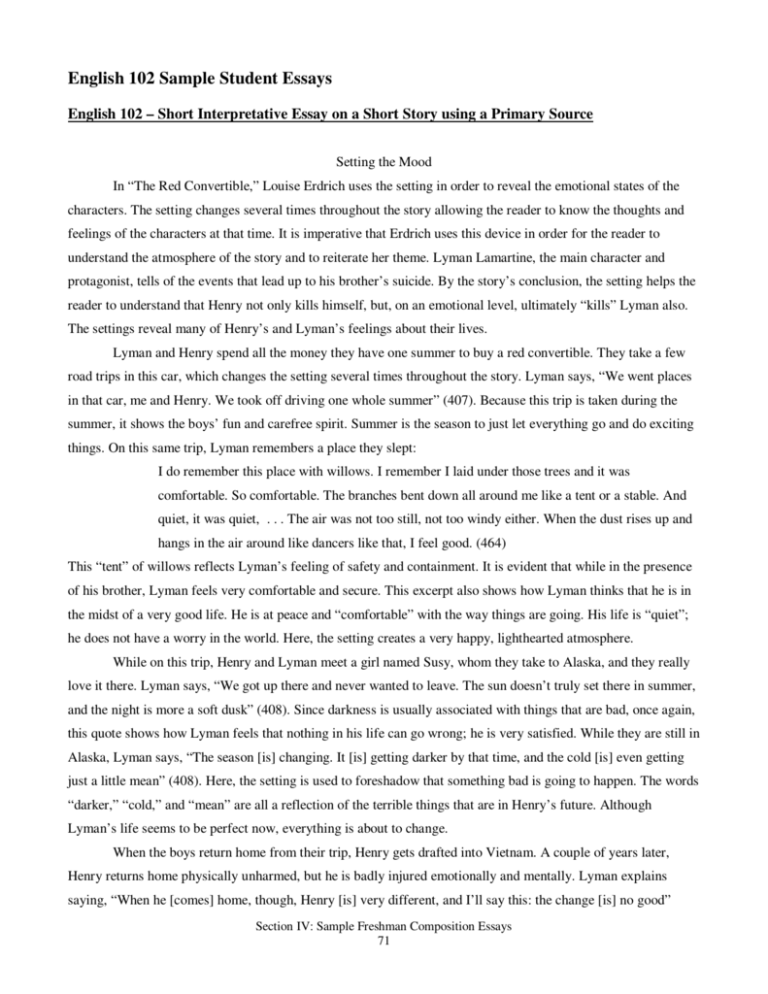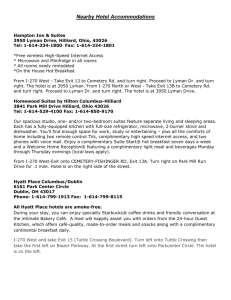Red Convertible: Setting & Emotion - Student Essay
advertisement

English 102 Sample Student Essays English 102 – Short Interpretative Essay on a Short Story using a Primary Source Setting the Mood In “The Red Convertible,” Louise Erdrich uses the setting in order to reveal the emotional states of the characters. The setting changes several times throughout the story allowing the reader to know the thoughts and feelings of the characters at that time. It is imperative that Erdrich uses this device in order for the reader to understand the atmosphere of the story and to reiterate her theme. Lyman Lamartine, the main character and protagonist, tells of the events that lead up to his brother’s suicide. By the story’s conclusion, the setting helps the reader to understand that Henry not only kills himself, but, on an emotional level, ultimately “kills” Lyman also. The settings reveal many of Henry’s and Lyman’s feelings about their lives. Lyman and Henry spend all the money they have one summer to buy a red convertible. They take a few road trips in this car, which changes the setting several times throughout the story. Lyman says, “We went places in that car, me and Henry. We took off driving one whole summer” (407). Because this trip is taken during the summer, it shows the boys’ fun and carefree spirit. Summer is the season to just let everything go and do exciting things. On this same trip, Lyman remembers a place they slept: I do remember this place with willows. I remember I laid under those trees and it was comfortable. So comfortable. The branches bent down all around me like a tent or a stable. And quiet, it was quiet, . . . The air was not too still, not too windy either. When the dust rises up and hangs in the air around like dancers like that, I feel good. (464) This “tent” of willows reflects Lyman’s feeling of safety and containment. It is evident that while in the presence of his brother, Lyman feels very comfortable and secure. This excerpt also shows how Lyman thinks that he is in the midst of a very good life. He is at peace and “comfortable” with the way things are going. His life is “quiet”; he does not have a worry in the world. Here, the setting creates a very happy, lighthearted atmosphere. While on this trip, Henry and Lyman meet a girl named Susy, whom they take to Alaska, and they really love it there. Lyman says, “We got up there and never wanted to leave. The sun doesn’t truly set there in summer, and the night is more a soft dusk” (408). Since darkness is usually associated with things that are bad, once again, this quote shows how Lyman feels that nothing in his life can go wrong; he is very satisfied. While they are still in Alaska, Lyman says, “The season [is] changing. It [is] getting darker by that time, and the cold [is] even getting just a little mean” (408). Here, the setting is used to foreshadow that something bad is going to happen. The words “darker,” “cold,” and “mean” are all a reflection of the terrible things that are in Henry’s future. Although Lyman’s life seems to be perfect now, everything is about to change. When the boys return home from their trip, Henry gets drafted into Vietnam. A couple of years later, Henry returns home physically unharmed, but he is badly injured emotionally and mentally. Lyman explains saying, “When he [comes] home, though, Henry [is] very different, and I’ll say this: the change [is] no good” Section IV: Sample Freshman Composition Essays 71 (465). During this time, the setting of the story is at the home of Henry and Lyman. The reader can see how badly the war has affected Henry, considering the fact that he does not even feel safe in his own home. It is here where the atmosphere first changes from blissful to miserable. Lyman gets a glimpse of his future, realizing that it is not going to be perfect. When Henry seems to be feeling a lot better, emotionally, he and Lyman embark on their second road trip. Here, the setting contradicts the happy, pleasant setting of the first trip. When they get to the river, it is “high and full of trash ... The sun [is] still out, but it [is] colder by the river” (467). The cold weather and the trash represent Henry’s desperate mindset. This is the place where Henry “throws away” his life. The story also says, “The water [has not] gone over the banks yet, but it [will], you [can] tell. It [is] at its limit, hard swollen, glossy like an old gray scar” (467). Henry, like the river, is about to go over the edge emotionally. He is obviously very unhappy in his current life, and if he does not do something about it, he is going to go crazy. Unfortunately, in this case, Henry believes his only way out is to take his own life. After Henry commits suicide, Lyman makes the statement, “the sun is down” (469). This reflects Henry’s death; the sun has set on his life. This also shows Lyman’s devastated state of mind and creates a very lonely and melancholy mood. Lyman has lost his only brother with whom he had such a loving bond. He knows that his life will never be the same. This situation is proof that suicide is a selfish act because of the profound negative effects it has on other people. The various settings in “The Red Convertible” reflect the mental states of the characters. By analyzing the setting, the reader can see the drastic emotional changes that Henry and Lyman undergo. With Henry’s suicide and Lyman’s obvious heartache, Erdrich illustrates her theme that suicide is a selfish act that results in longlasting effects on the victim’s loved ones. Work Cited Erdrich, Louise. “The Red Convertible.” Literature and the Writing Process. Ed. Elizabeth McMahan, Susan X Day, and Robert Funk. 6th ed. Upper Saddle River, NJ: Prentice-Hall, 2002. 407-413. Print. Section IV: Sample Freshman Composition Essays 72






